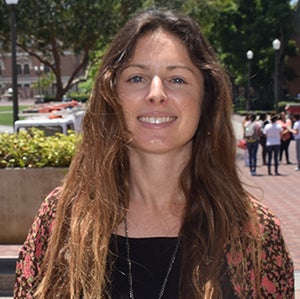Center for Advanced Genocide Research Awards USC Graduate Student Research Fellowship to Erin Mizrahi

USC Shoah Foundation’s Visual History Archive is a tool that allows genocide survivors to tell their stories. But it isn’t their words that summer research fellow Erin Mizrahi is interested in; it’s their silence.
Mizrahi, a fifth-year Comparative Studies in Literature and Culture Ph.D. student at USC, is studying silence as a theoretical approach through two very different subjects: sexual assault in performance art and the Holocaust.
“Extreme violence is the link [between the subjects] — how hard it is to tell the story and also thinking about how difficult it is to bear witness to something that horrible,” she said.
Mizrahi is spending her four weeks as a Center for Advanced Genocide Research fellow watching testimony and observing different kinds of silence within them. So far she has developed five different categories of silence she has seen in testimony: moments of silence, omissions, reluctance to speak, impossibility of telling, and silence as survival.
“I didn’t want to limit my research solely to these moments [of silence] because I discovered a larger rhetoric of silence that carried through many of the testimonies,” she said.
Moments of silence are extended periods where a survivor doesn’t speak for emotional reasons, omissions are when survivors say that they can’t tell an interviewer something, reluctance to speak is when a survivor doesn’t want to talk about a subject, and impossibility of telling is when survivors feel that words cannot do their story justice.
“One survivor Stella Levi said, ‘There are no words to describe the world that is Auschwitz,’” Mizrahi said. “There was a very long silence following her statement; when there are no words we must find a way to let silence speak.”
Silence as survival is slightly different from the rest of the categories as it is not part of the testimony video as much as it is about the story. It is when survivors survived by literally staying silent, perhaps so the Nazis thought they were dead and they could later escape.
“[Those] stories are just completely harrowing,” Mizrahi said. “But there is this very positive kind of nature of silence as survival.”
Though Mizrahi went in with some ideas about when moments of silence would occur in testimony, she said she was surprised by a lot of what she found out, for instance with Allied liberators of concentration camps.
“I listened to some testimony by the liberators and they all said nobody talked about it after, which really shocked me,” she said. “It is something I expected from survivors but it didn’t even occur to me that it would be an issue for liberators not wanting to say what they saw.”
While silence is often seen as a bad things — both in research and in social interactions — Mizrahi is focusing on the good that can come from it.
“Silence is often seen as this thing that breaks communication, and I’m looking at it as something that lets you connect especially in these moments that are extremely difficult to tell and difficult to listen,” she said.
After her time at the Institute is over, Mizrahi will take work on incorporating her research into her dissertation. She said that the time she spent watching testimony and learning personal stories will strongly impact her project and that having now witnessed these personal stories, she will be reframing the theory in a very different light.
“Having spent all this time watching these personal stories is going to drastically impact how I now go back and approach the chapter on the Shoah,” she said.